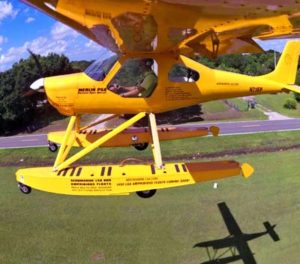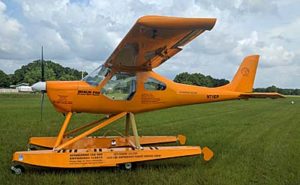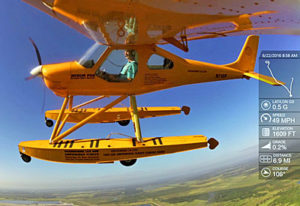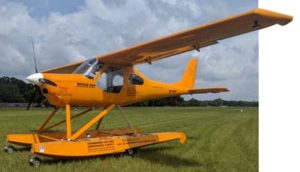It’s summer. It’s hot. The water beckons. Yet, you’re a pilot. How do you enjoy both? Get a seaplane, preferably a Light-Sport or light kit seaplane. You have several choices. The trouble is that any seaplane is priced well above landplanes of similar configuration. Some LSA seaplanes smash through the $200,000 barrier. That may represent a fair value for what you get but it exceeds the budget of many recreational pilots. How about $55,000 to $65,000? That sounds better, doesn’t it?
Runway testing and cross country trials of the float-equipped Merlin PSA is complete. Aeromarine LSA owner Chip Erwin reports performing stalls, turns, climb, and cruise tests, each of which passed his criteria, although he continues in trials. The floatplane Merlin has not yet entered the water but that will happen in days after Chip finishes his initial wringing out of the float version. These floats are amphibious so land trials made sense at first.
Chip reports, “I have been using the 1730 millimeter (68 inch) DUC Hélices Flash prop because theoretically it is better for acceleration and climb which is nice to have on a seaplane.” He reported good results with about a 900 foot per minute climb rate and cruise at 85-92 mph.
Yet cruise was definably better with the smaller (1660 mm / 65 inch) prop so Chip noted, “From a business perspective I really only need to offer that prop.” He added that it works fine on floats or wheels and that makes inventory stocking easier. “Using the 1660 mm prop set for cruise pitch I saw 100 mph TAS at only 2,000 feet, with floats!” Given Merlin PSA’s roomy solo cockpit that includes baggage space, hitting 100 mph on floats qualifies as good performance.
Even backed off to 5500 rpm for better economy, speed was 96 mph TAS and 91 mph indicated, Chip reported. That’s a fair pace given he plans to fly from central Florida to Oshkosh for AirVenture 2016.
Longtime light aviation entrepreneur, Chip Erwin (the original developer of the popular SportCruiser) knows a thing or two about floats. Besides developing several airplanes — one of which was a pioneering LSA seaplane called Mermaid — his then-Czech-based company also developed aluminum floats.
Chip identifies three ingredients that make for a good floatplane: (1) plenty of wing area, perhaps explaining why the Brazilian Super Petrel flies well as a biplane seaplane; (2) plenty of horsepower, clarifying why many LSA seaplane designers flocked to Rotax’s new 915 that will provide 135 horsepower when ready; and, (3) big floats, which might explain why a set of Aerocet floats for a CubCrafters cost more than $50,000… only for the floats and related gear.
Merlin PSA on floats is a single seater. I’ll come back to that but it makes clear why Merlin’s wings qualify as big. You might not think a 65-horsepower Rotax 582 represents a lot of power but for a light single seater, it most certainly is. The wheeled version is a very lively performer. Finally, Merlin’s floats support 800 pounds, each!, illustrating why a pair of them sit so high in the water. Get all Merlin specs.
What may be more surprising is that the choice of a single seater makes Merlin hit all Chip’s points: its wing is large; power is high for its weight; and the floats have minimum draft… all of which make this new light kit a solid performer.
Nonetheless, I can hear your lament, “But it’s only a single seater.” Let me observe two things: First, most airplanes with two or even four seats are most commonly flown solo. Years of surveying told AOPA that the average occupancy of a typical (four seat) GA plane was 1.6, suggesting that overwhelmingly these aircraft are flown with only the pilot on board. Secondly, most seaplanes are flown solo. Chip likes to joke,” You can spend $100,000 more than Merlin but that’s a lot of money for your cellphone holder… the empty seat next to you. Seriously, think about it. How many times do you truthfully fill both or all your seats?
If you have to take someone or the whole family aloft, go rent a Cessna 172 somewhere. They are common and if you have a medical, problem solved. For all the times when you fly solo, Merlin will offer a dashing example, and one that saves you a bundle. Sold in kit form, you can start with a wheeled Merlin and basic equipment, getting aloft for $28,000 powered by the Rotax 582.
“Alright,” you say, “but what if I just don’t like two stroke engines?” Even if you don’t accept that Rotax has sold tens of thousands of these engines that have been proven reliable in millions of hours of flying, Aeromarine LSA has a four stroke Merlin in late stages of development. By fall 2016, you should also be able to choose the HKS for about $3,000 additional. It may offer slightly less climb than the Rotax 582, but it should cruise at a similar speed and will burn half the fuel. In reality, though, many readers of this website know the Rotax 582 is as bulletproof as a two stroke gets, and the price is right. So is the nationwide, indeed worldwide, support.
As he knows floats and fitting them to various airplanes better than many aviation business owners, I asked for more float tips. Chip identified three guidelines.
The first was the pattern of a more wing area, plenty of power, and large enough floats. The second point is that floats tend to cost about 20% of climb and cruise performance and, of course, this factors in to how long it runs on water before launching; less time is always better because floatplanes can take a pounding on some water surfaces. That’s why you always hear seaplane people discussing the number of seconds before they leave the surface. The third point is that, in general, you don’t lose payload by adding floats. That sounds counterintuitive given the weight of floats and amphib gear, but Chip maintains that, “The floats lift themselves, using shape and angle of attack.” Because seaplanes fly a bit slower, they can also tolerate turbulence reasonably well.
You can catch the video below to see — via text lines added in editing — facts about how long Merlin remains on the ground, on hard surface or turf, plus other parameters.
However, I come back to that old saw about what is the essential ingredient to make flight possible: money! Merlin PSA on floats — even equipped with BRS parachute, TruTrak ECO autopilot, ADS-B out transponder, amphibious gear, and all the features you’d expect on most recreational aircraft — will list at just $65,000. Given that is less than we expected a dozen years ago for most Light-Sport Aircraft, on wheels!, that is a definite bargain. Yes, you have to build it; it’s a kit. However, the $65K price tag is for the quick-build model including builder assistance in central Florida (not far from Disney so the family can amuse themselves while you pull rivets). In a couple, three weeks you’ll be close to done and that isn’t bad for an airplane bound to put a smile on your face.






Leave a Reply